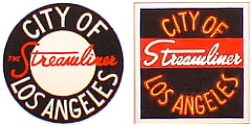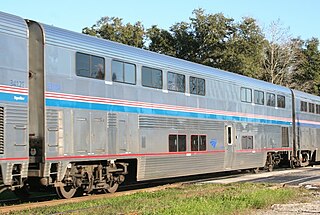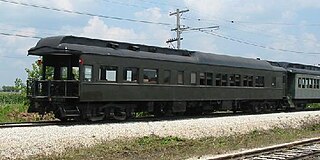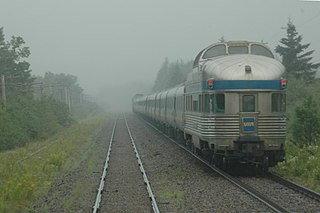
The Superliner is a type of bilevel intercity railroad passenger car used by Amtrak, the national rail passenger carrier in the United States. Amtrak ordered the cars to replace older single-level cars on its long-distance trains in the Western United States. The design was based on the Budd Hi-Level vehicles, employed by the Santa Fe Railway on its El Capitan trains. Pullman-Standard built 284 cars, known as Superliner I, from 1975 to 1981; Bombardier Transportation built 195, known as Superliner II, from 1991 to 1996. The Superliner I cars were the last passenger cars built by Pullman.

The City of Los Angeles was a streamlined passenger train between Chicago, Illinois, and Los Angeles, California via Omaha, Nebraska, and Ogden, Utah. Between Omaha and Los Angeles it ran on the Union Pacific Railroad; east of Omaha it ran on the Chicago and North Western Railway until October 1955 and on the Milwaukee Road thereafter. The train had number 103 westbound and number 104 eastbound.

A passenger railroad car or passenger car, also called a passenger carriage, passenger coach, or passenger bogie (India) is a railroad car that is designed to carry passengers. The term passenger car can also be associated with a sleeping car, a baggage car, a dining car, railway post office and prisoner transport cars.

A dome car is a type of railway passenger car that has a glass dome on the top of the car where passengers can ride and see in all directions around the train. It also can include features of a coach, lounge car, dining car, sleeping car or observation. Beginning in 1945, dome cars were primarily used in the United States and Canada, though a small number were constructed in Europe for Trans Europ Express service, and similar panorama cars are in service on Alpine tourist railways like the Bernina Express.

An observation car/carriage/coach is a type of railroad passenger car, generally operated in a passenger train as the rearmost carriage, with windows on the rear of the car for passengers' viewing pleasure. The cars were nearly universally removed from service on American railroads beginning in the 1950s as a cost-cutting measure in order to eliminate the need to "turn" the trains when operating out of stub-end terminals.

The Budd Company was a 20th-century metal fabricator, a major supplier of body components to the automobile industry, and a manufacturer of stainless steel passenger rail cars, airframes, missile and space vehicles, and various defense products.

The Budd Rail Diesel Car, RDC, Budd car or Buddliner is a self-propelled diesel multiple unit (DMU) railcar. Between 1949 and 1962, 398 RDCs were built by the Budd Company of Philadelphia, Pennsylvania, United States. The cars were primarily adopted for passenger service in rural areas with low traffic density or in short-haul commuter service, and were less expensive to operate in this context than a traditional diesel locomotive-drawn train with coaches. The cars could be used singly or coupled together in train sets and controlled from the cab of the front unit. The RDC was one of the few DMU trains to achieve commercial success in North America. RDC trains were an early example of self-contained diesel multiple unit trains, an arrangement now in common use by railways all over the world.

The El Capitan was a streamlined passenger train operated by the Atchison, Topeka and Santa Fe Railway between Chicago, Illinois, and Los Angeles, California. It operated from 1938 to 1971; Amtrak retained the name until 1973. The El Capitan was the only all-coach or "chair car" to operate on the Santa Fe main line between Chicago and Los Angeles on the same fast schedule as the railroad's premier all-Pullman Super Chief. It was also the first train to receive the pioneering Hi-Level equipment with which it would become synonymous.

The Ocean, previously known as the Ocean Limited, is a passenger train operated by Via Rail in Canada between Montreal, Quebec, and Halifax, Nova Scotia. It is the oldest continuously operated named passenger train in North America. The Ocean's schedule takes approximately 23 hours, running overnight in both directions. Together with The Canadian and Via's corridor trains, the Ocean provides a transcontinental service.

The Denver Zephyr was a streamlined passenger train operated by the Chicago, Burlington and Quincy Railroad between Chicago, Illinois, and Denver, Colorado. In peak years it ran to Colorado Springs. It operated from 1936 to 1973. The Denver Zephyr continued operating after the Burlington Northern Railroad merger in 1970. BN conveyed the train to Amtrak in 1971; Amtrak merged it with the Denver–Oakland City of San Francisco to form the San Francisco Zephyr and dropped the "Denver" name in 1973.

Amfleet is a fleet of single-level intercity railroad passenger cars built by the Budd Company for American company Amtrak in the late 1970s and early 1980s. Budd based the Amfleet design on its earlier Metroliner electric multiple unit. An initial order for 57 cars in 1973 to supplement the Metroliners on the Northeast Corridor grew to two orders totaling 642 cars, sufficient to reequip all the services on the Northeast Corridor and many other routes around the United States. The first 492 cars, known as Amfleet I and completed between 1975–1977, were designed for short-distance service. A second order of 150 cars, known as Amfleet II and completed between 1980–1983, were designed for long-distance service. They were the last intercity passenger cars built by Budd.

The Branson Scenic Railway is a heritage railroad in Branson, Missouri. The trains depart from a historic depot in downtown Branson and operate in the scenic Ozark Mountains for an approximate 40-mile (64 km) round trip.
The streamliners are a class of streamlined railway cars built in the 1940s through the 1950s for long distance passenger railservices in North America.

The Big Domes were a fleet of streamlined dome cars built by the Budd Company for the Atchison, Topeka and Santa Fe Railway in 1954. Budd built a total of 14 cars in two batches. The Santa Fe operated all 14 on various streamlined trains until it conveyed its passenger trains to Amtrak in 1971. The Santa Fe retained one as a business car and sold the remaining 13 to the Auto-Train Corporation, which operated them for another ten years. All but two have been preserved in varying condition.

The Hi-Level was a type of bilevel intercity railroad passenger car used in the United States. Car types included coaches, dining cars, and lounge cars. Most passenger spaces were on the upper level, which featured a row of windows on both sides. Boarding was on the lower level; passengers climbed up a center stairwell to reach the upper level. Vestibules on the upper level permitted passengers to walk between cars; some coaches had an additional stairwell at one end to allow access to single-level equipment. Santa Fe and Budd considered but never created a sleeping car.

The Super Dome was a Dome car built by Pullman-Standard for the Chicago, Milwaukee, St. Paul and Pacific Railroad in 1952. The ten Super Domes were the first full-length dome cars in revenue service, first operating on the Olympian Hiawatha and Twin Cities Hiawatha in late 1952. Although a mixed blessing in passenger use, the cars garnered much publicity for the Milwaukee Road and several remain in operation.

The Park series or Park car is a fleet of lightweight streamlined dome-sleeper-observation cars built by the Budd Company for the Canadian Pacific Railway in 1954. Sixteen of the cars were named for a Canadian national or provincial park, while one was named for a wildlife reserve, and one was named for what was at the time a private park owned by Canadian Pacific subsidiary Dominion Atlantic Railway, but is now one of the National Historic Sites of Canada. Via Rail acquired the fleet from Canadian Pacific in 1978 and the majority of the cars remain in active service.

The Manor series is a fleet of 42 lightweight streamlined sleeping cars built by the Budd Company for the Canadian Pacific Railway in 1954–1955. Each contained five bedrooms, one compartment, four sections and four roomettes. The cars were named for distinguished English Canadians. Via Rail acquired the fleet from the Canadian Pacific in 1978 and the cars remain in active service.

The Château series is a fleet of 29 lightweight streamlined sleeping cars built by the Budd Company for the Canadian Pacific Railway in 1954. Each contained eight duplex roomettes, four sections, three bedrooms, and one drawing room. The cars were named for distinguished French Canadians. Via Rail acquired the fleet from the Canadian Pacific in 1978 and the cars remain in active service.

The Great Domes were a fleet of six streamlined dome lounge cars built by the Budd Company for the Great Northern Railway and Chicago, Burlington and Quincy Railroad in 1955. The cars were used exclusively on the Empire Builder from their introduction in 1955 until the end of private passenger service in 1971. Amtrak retained all six cars and they continued to run on the Empire Builder before new Superliners displaced them at the end of the decade, after which they saw service elsewhere in the system before the last one being retired in 2019. The Great Domes were similar in design to the Big Domes Budd built for the Atchison, Topeka and Santa Fe Railway.




















